Contact us
Call us at
Available 9 AM - 5 PM CET Business Days
Download
Download Manuals, Datasheets, Software and more:
Feedback
Vector and RF Suite of Signal Analysis Software for PC
SignalVu-PC Applications Datasheet
More Information
- Spectrum Analyzer Software for RF & Vector Signals
- Product Support
- Explore more Software models
Read Online:
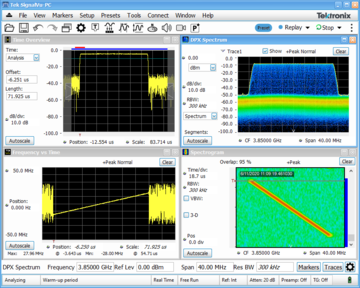
SignalVu-PC enables powerful RF and vector signal analysis using Tektronix real-time spectrum analyzers and MDO/DPO Series oscilloscopes.
Key features
- Multi-domain tool set for spectrum analysis, vector signal analysis, demodulation, and more including:
- Offline analysis of waveforms captured by all Tektronix spectrum analyzers and oscilloscopes
- Real-time recording and analysis with Tektronix RSA signal analyzers (RSA7100, RSA600, RSA500, and RSA306 Series)
- Options for multi-channel acquisition and analysis with Tektronix MSO/DPO oscilloscopes (5/6 Series MSO, LPD64, and MSO/DPO70000SX/DX models)1
- Analyze wideband designs
- Enhance data analysis with the ability to leverage the processing power of Windows PCs and tablets, including the Tektronix 5/6 Series MSO with an embedded Windows OS
- Node Locked and Floating License available for each SignalVu-PC optional application
- Analyze
- Extensive time-correlated, multi-domain displays connect problems in time, frequency, phase, and amplitude for quicker understanding of cause and effect when troubleshooting
- Advanced pulse radar analysis suite - automated pulse measurements provide deep insight into pulse train behavior. Measure pulse statistics over many acquisitions (millions of pulses). Multi-channel analysis is enabled with MSO/DPO oscilloscopes
- Power measurements and signal statistics help you characterize components and systems: ACLR, Multicarrier ACLR, Power vs. Time, CCDF, and OBW/EBW
- EMC/EMI pre-compliance and troubleshooting with RSA signal analyzers - CISPR detectors, predefined standards, limit lines, easy accessory setup, ambient capture, failure analysis, and report generation
- WLAN spectrum and modulation transmitter measurements based on IEEE 802.11 a/b/g/j/p/n/ac/ad/ay standards
- Bluetooth® Transmitter Measurements based on Bluetooth SIG RF specifications for Basic Rate, Low Energy, and Bluetooth 5. Few supports the Enhanced Data Rate measurement
- Settling time measurements, frequency, and phase for characterization of wideband frequency-agile oscillators
- General-purpose digital modulation analysis (SVM) provides modulation analysis of 26 modulation types from FSK to 1024QAM. Multi-channel analysis is enabled with MSO/DPO Oscilloscopes
- Flexible OFDM analysis of custom OFDM signals
- Frequency offset control for analyzing baseband signals with near-zero intermediate frequencies (IF)
- AM/FM/PM modulation and audio measurements for characterization of analog transmitters and audio signals
- Simple and complete APCO Project 25 transmitter compliance testing and analysis for Phase 1 (C4FM) and Phase 2 (TDMA)
- Playback of recorded files from the USB spectrum analyzers (RSA306, RSA500, and RSA600)
- LTE™ FDD and TDD Base Station (eNB) Transmitter RF measurements
- Automated Phase Noise/Jitter measurements
- Signal Classification and Survey
- Mapping
- 5G New Radio (NR) uplink/downlink RF power, Power dynamics, Signal quality, and Emissions measurements based on the 3GPP release 15/16 Standard
Applications
- Wideband radar and pulsed RF signals
- Frequency agile communications
- Broadband satellite and microwave backhaul links
- Wireless LAN, Bluetooth, Commercial Wireless
- Land Mobile Radio (LMR), APCO P25
- Education
- Long Term Evolution (LTE), Cellular
- 5G NR Cellular base station or user equipment transmitter test
- EMC/EMI pre-compliance and troubleshooting
Advanced triggers
Besides traditional external and RF power triggers, SignalVu-PC offers advanced triggering capabilities:
- Time-qualified triggers enable capture of events at desired pulse widths, ideal for capturing dynamic test environments
- Frequency mask triggers facilitate definition of a spectrum mask to capture events or signal anomalies based on their frequency and amplitude
- DPX density trigger lets you analyze and measure infrequent or elusive RF events by defining a spectrum measurement box by frequency and amplitude, and using the percentage of time that the signal falls withing the box to trigger the capture
Capture with variety of tools
The software offers a comprehensive solution for analyzing RF (Radio Frequency) systems performance at every stage, from initial laboratory research through field testing to factory production. Designed for a seamless user experience across various windows devices, it enables you to gain valuable insights wherever you are.
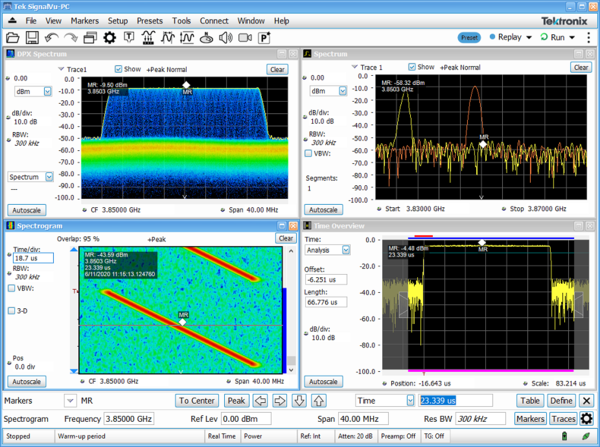
Capture once - make multiple measurements without recapturing. Once stored in memory, SignalVu-PC provides detailed analysis in multiple domains, saving you time and enhancing your insight.
For example, the spectrogram display (bottom left panel of the image) shows how the frequency of an LFM (Linear Frequency Modulation) radar pulse changes over time. By selecting a specific moment during the pulse's active phase, you can observe the chirp's behavior as it transitions from low to high frequencies, as depicted in the upper right panel.
Setups, captures, and recordings are easily shareable among teams, for boosting collaboration and analysis.
Moreover, optional pulse radar analysis software enables you to analyze the pulse's modulation characteristics and measure other essential parameters like pulse width and repetition intervals from the same captured data.
This approach provides a deep dive into the system's performance without the need for additional data captures, streamlining your workflow and enriching your insights.
Connect with 5/6 Series B MSO or 6 Series LPD oscilloscopes
When the base connectivity CON option is installed, SignalVu-PC extends the functionality of either the 5/6 Series B MSO or 6 Series LPD oscilloscopes (with hardware option SV-RFVT). The combination of hardware and software transforms the oscilloscope into a wideband vector signal analyzer (VSA) with up to 2 GHz capture bandwidth on up to eight independent channels2. To support acquisition length of more than 10 ms for a span of 2 GHz, RL-1 (125 Mpoints record length) license needs to be installed. SignalVu-PC can either run on the instrument (with optional Windows 10 SSD; 5/6-WIN) or on separate Windows PC connected via USB or LAN to the instrument.
SignalVu-PC controls the MSO RF front-end, acquires the vector-calibrated I/Q data, and makes wide-band, time-correlated, multi-domain measurements. You can analyze, correlate, and troubleshoot issues in time, frequency, phase, amplitude, and modulation.
In addition to simultaneous multi-channel Spectrums, Spectrograms, Channel Power, ACPR, OBW, RF Amplitude, Frequency and Phase vs. Time traces, Triggers, and IQ capture capability, SignalVu-PC and the Base Connectivity option adds essential VSA measurements and statistical analysis including RF I&Q vs. Time, CCDF, MCPR, SEM, Spurious, AM, FM, PM, and Automated Mask Search displays and alerts.
Leverage the MSO triggering capability and low phase noise performance to extend your debugging work into system-level validation and troubleshooting of your embedded RF devices. Perform modulation analysis and pass/fail testing of the most common wireless standards and modulation types with optional SignalVu-PC applications.
Analyze
Time-correlated measurements can be made of frequency, phase, amplitude, and modulation versus time. This is ideal for signal analysis that includes frequency hopping, pulse characteristics, modulation switching, settling time, bandwidth changes, and intermittent signals.
Acquisitions from the USB Spectrum Analyzers and all Tektronix MSO/DPO Series oscilloscopes can be analyzed with SignalVu-PC, adding deep analysis capabilities to these broadband acquisition systems.

Time-correlated, multi-domain, multi-channel views provide a new level of insight into design or operational problems not possible with conventional analysis solutions. Here, the hop patterns of a narrowband signal can be observed using Spectrogram (upper right) and its hop characteristics can be precisely measured with Frequency vs Time display (bottom left). The time and frequency responses can be observed in the two views right as the signal hops from one frequency to the next. All of the analysis shown above is available in the free base version of SignalVu-PC.
Multi-channel support
Simultaneously acquire, independently configure settings, and analyze data from up to eight channels of the 5 or 6 Series MSO Oscilloscope using the general signal viewing (with option CON or SVE), advanced pulse radar analysis (SVP), and general-purpose digital modulation analysis (SVM) displays of SignalVu-PC.
This approach enables a comprehensive understanding of complex systems, such as RADAR, MIMO, uplink/downlink systems, and phased-array systems. It facilitates the examination of multiple signals across various parameters, including power, time, frequency, phase, and modulation by allowing you to independently configure channel settings such as center frequency, span, RBW, reference level, and analysis time. Available global settings control saves valuable time configuring multiple channels.
In addition to RF, you can analyze baseband signals by configuring channels as I/Q, or differential I/Q.
For multi-channel applications greater than 10 GHz in frequency, up to 70 GHz can be simultaneously analyzed on up to four channels using Tektronix DPO70000SX oscilloscopes. Refer to SignalVu for Performance Oscilloscopes for more details.
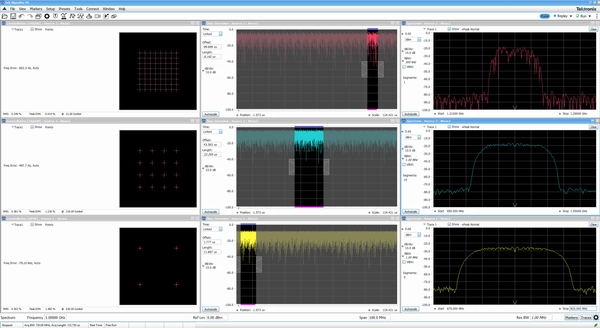
Shared acquisition multi-signal support
SignalVu-PC software expands your analysis capabilities even further on oscilloscope by enabling simultaneous analysis of multiple frequency dispersed signals within a single acquisition bandwidth. By configuring multiple sources to one physical oscilloscope channel, it supports independent analysis of signals at different frequency bands from I/Q data acquired by a single channel. This capability offers critical insights into advanced, multi-standard systems, streamlining development and validation.
One example among many where such analysis is beneficial involves electronic warfare or military communications research, where analyzing pulse radar and 64QAM signals simultaneously on the same medium helps test and ensure system reliability under mixed signal conditions.

Optional applications tailored for your RF applications
The base SignalVu-PC version ships free3 and enables 16 or more general signal viewing and RF measurement displays including spectrum analysis, RF power and statistics, spectrograms, amplitude, frequency and phase versus time, and analog modulation measurements. Field-upgradeable software options may be added, including pulse radar analysis, general-purpose modulation analysis, settling time, automated phase noise measurements, EMI pre-compliance, commercial standard analysis (WLAN, Bluetooth, LTE, 5G NR), playback of recorded files, and more.

From FSK to 1024QAM, general-purpose digital modulation analysis (SVM) provides precise modulation accuracy and essential physical-layer measurements for 26 prevalent digital modulation types.

Advanced pulse analysis
The advanced pulse analysis package (SVP) provides 31 individual measurements to automatically characterize long pulse trains often associated with RADAR. An 850 MHz wide LFM chirp centered at 3.85 GHz is seen here with measurements for pulses 7 through 14 (top right). The shape of the pulse can be seen in the Amplitude vs. Time plot shown in the upper left. Detailed views of pulse #8's frequency deviation and parabolic phase trajectory are shown in the lower two views.

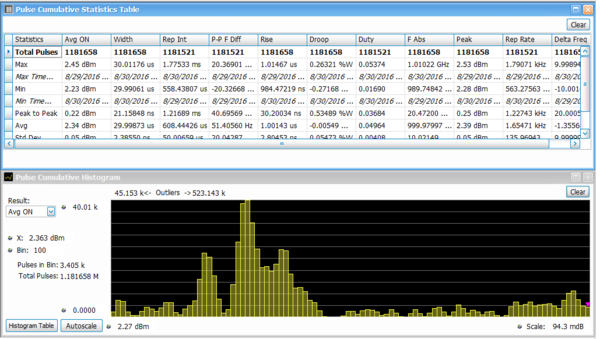
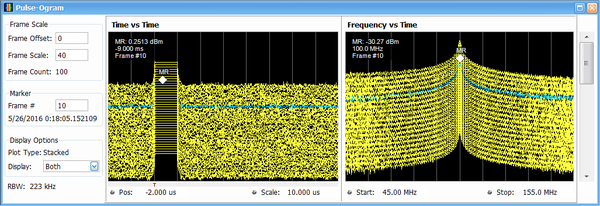

Multi-channel support is enabled when the 5/6 Series MSO instruments are used. This allows you to capture and analyze up to 8 phase-coherent RF pulse trains of up to 5 GHz in frequency and up to 2 GHz in bandwidth. Or up to 4 pulse trains of up to 10 GHz in frequency and up to 2 GHz in bandwidth.
WLAN sub 6 GHz Wi-Fi transmitter testing
With the WLAN measurement applications, you can perform standards-based transmitter measurements in the time, frequency, and modulation domains.
- SV23 supports IEEE 802.11a, b, g, j, and p signals
- SV24 supports 802.11n 20 MHz and 40 MHz SISO signals
- SV25 802.11ac 20/40/80/160 MHz SISO signals
All modulation formats, as shown in the following table can be measured.
| Standard | Std PHY | Freq band(s) | Signal | Modulation formats | Bandwidth (max) | 802.11- 2012 section |
|---|---|---|---|---|---|---|
| 802.11b | DSSS HR/DSSS | 2.4 GHz | DSSS/CCK 1 - 11 Mbps | DBSK, DQPSK CCK5.5M, CCK11M | 20 MHz | 16 & 17 |
| 802.11g | ERP | 2.4 GHz | DSSS/CCK/PBCC 1 - 33 Mbps | BPSK DQPSK | 20 MHz | 17 |
| 802.11a | OFDM | 5 GHz | OFDM 64 <54 Mbps | BPSK QPSK 16QAM 64QAM | 20 MHz | 18 |
| 802.11g | 2.4 GHz | 20 MHz | 19 | |||
| 802.11j/p | 5 GHz | 5, 10, 20 MHz | 18 | |||
| 802.11n | HT | 2.4 GHz & 5 GHz | OFDM 64, 128 ≤ 150 Mbps | BPSK QPSK 16QAM 64QAM | 20 , 40 MHz | 20 |
| 802.11ac | VHT | 5 GHz | OFDM 64, 128, 256, 512 ≤ 867 Mbps | BPSK QPSK 16QAM 64QAM 256QAM | 20, 40, 80, 160 MHz | 22 |
The WLAN presets make the Error Vector Magnitude (EVM), Constellation, and Spectral Emission Mask (SEM) measurements push-button.
The WLAN RF transmitter measurements are defined by the IEEE 802.11- 2012 revision of the standard. Analysis of 1024-QAM 802.11ac signals is also possible.
| IEEE 802.11 RF layer test | IEEE reference 802.11-2012 | Limit tested |
|---|---|---|
| Transmit Power ON/Off Ramp | 16.4.7.8 (DSSS) | (10%-90%) 2 usec |
| 17.4.7.7 ("b") | (10%-90%) 2 usec | |
| Transmit Spectrum mask | 16.4.7.5 (DSSS) | std mask |
| 17.4.7.4 ("b") | std mask | |
| 18.3.9.3 ("a") | std mask | |
| 19.5.5 ("g") | std mask | |
| 20.3.20.1 ("n") | std mask | |
| 22.3.18.1 ("ac") | std mask | |
| RF Carrier suppression | 16.4.7.9 ("DSSS") | -15 dB |
| 17.4.7.8 ("b") | -15 dB | |
| Centre frequency leakage | 18.3.9.7.2 ("a") | -15 dBc or +2 dB with respect to average subcarrier power |
| 20.3.20.7.2 ("n") | 20 MHz follow 18.3.9.7.2 | |
| 40 MHz -20dBc or 0 dB with respect to average subcarrier power | ||
| Transmit Spectral flatness | 18.3.9.7.3 ("a") | +/-4dB (SC = -16... 16), +4/-6 dB (other) |
| 20.3.20.2 ("n") | +/-4dB, +4/-6 dB | |
| 22.3.18.2 ("ac") | +/-4dB, +4/-6 dB (various BWs, 20-160 MHz) | |
| Transmit Spectral flatness | 18.3.9.7.3 ("a") | +/-4 dB (SC = -16... 16), +4/-6 dB (other) |
| 20.3.20.2 ("n") | +/-4 dB, +4/-6 dB | |
| 22.3.18.2 ("ac") | +/-4 dB, +4/-6 dB (various BWs, 20-160 MHz) | |
| Transmit Centre frequency tolerance | 16.4.7.6 ("DSSS") | +/-25 ppm |
| 17.4.7.5 ("b") | +/-25 ppm | |
| 18.3.9.5 ("a") | +/-20 ppm (20 MHz and 10 MHz), +/- 10 ppm (5 MHz) | |
| 19.4.8.3 ("g") | +/-25 ppm | |
| 20.3.20.4 ("n") | +/-20 ppm (5 GHz band), +/- 25 ppm (2.4 GHz band) | |
| 22.3.18.3 ("ac") | +/-20 ppm | |
| Symbol clock frequency tolerance | 16.4.7.7 ("DSSS") | +/-25 ppm |
| 17.4.7.6 ("b") | +/-25 ppm | |
| 18.3.9.6 ("a") | +/-20 ppm (20 MHz and 10 MHz), +/-10 ppm (5 MHz) | |
| 19.4.8.4 ("g") | +/-25 ppm | |
| 20.3.20.6 ("n") | +/-20 ppm (5 GHz band), +/-25 ppm (2.4 GHz band) | |
| 22.3.18.3 ("ac") | +/-20 ppm | |
| Transmit Modulation accuracy | 16.4.7.10 ("DSSS") | Peak EVM < 0.35 |
| 17.4.7.9 ("b") | Peak EVM < 0.36 |
| IEEE 802.11 RF layer test | IEEE reference 802.11-2012 | limit | ||
|---|---|---|---|---|
| Transmitter Constellation Error | 18.3.9.7.4 ("a") | Modulation | Coding rate (R) | Relative constellation error |
| BPSK | 1/2 | -5 | ||
| BPSK | 3/4 | -8 | ||
| QPSK | 1/2 | -10 | ||
| QPSK | 3/4 | -13 | ||
| 16-QAM | 1/2 | -16 | ||
| 16-QAM | 3/4 | -19 | ||
| 64-QAM | 2/3 | -22 | ||
| 64-QAM | 3/4 | -25 | ||
| 20.3.20.7.3 ("n") | BPSK | 1/2 | -5 | |
| QPSK | 1/2 | -10 | ||
| QPSK | 3/4 | -13 | ||
| 16-QAM | 1/2 | -16 | ||
| 16-QAM | 3/4 | -19 | ||
| 64-QAM | 2/3 | -22 | ||
| 64-QAM | 3/4 | -25 | ||
| 64-QAM | 5/6 | -27 | ||
| 22.3.18.4.3 ("ac") | BPSK | 1/2 | -5 | |
| QPSK | 1/2 | -10 | ||
| QPSK | 3/4 | -13 | ||
| 16-QAM | 1/2 | -16 | ||
| 16-QAM | 3/4 | -19 | ||
| 64-QAM | 2/3 | -22 | ||
| 64-QAM | 3/4 | -25 | ||
| 64-QAM | 5/6 | -27 | ||
| 256-QAM | 3/4 | -30 | ||
| 256-QAM | 5/6 | -32 | ||
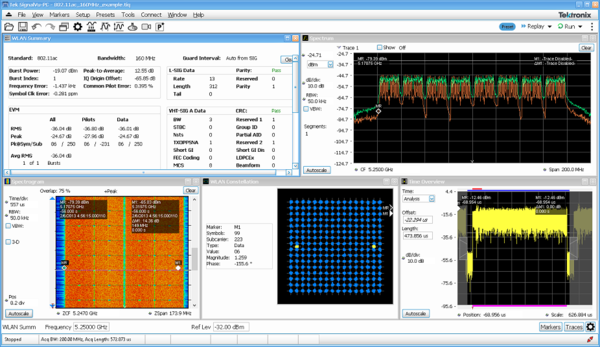
Bluetooth transmitter testing
Two options have been added to help with Bluetooth SIG standard base transmitter RF measurements in the time, frequency and modulation domains. Option SV27 supports Basic Rate and Low Energy Transmitter measurements defined by RF.TS.4.2.0 and RF-PHY.TS. 4.2.0 Test Specification. It also demodulates and provides symbol information for Enhanced Data Rate (EDR) packets. Option SV31 supports Bluetooth 5 standards (LE 1M, LE 2M, LE Coded) and measurements defined in the Core Specification. Both options also decode the physical layer data that is transmitted and color-encode the fields of packet in the Symbol Table for clear identification.
Pass/Fail results are provided with customizable limits and the Bluetooth presets make the different test set-ups push-button.
Below is a summary of the measurements that are automated with option SV27 and SV31 (unless noted):
- Bluetooth Low Energy (BLE) transmitter measurements
- Output power at NOC TRM-LE/CA/01/C and at EOC TRM-LE/CA/02/C
- In-band emission at NOC TRM-LE/CA/03/C and at EOC TRM-LE/CA/04/C
- Modulation characteristics TRM-LE/CA/05/C
- Carrier frequency offset and drift at NOC TRM-LE/CA/06/C and at EOC TRM-LE/CA/07/C
- Basic Rate transmitter measurements
- Output power TRM/CA/01/C
- Power Density TRM/CA/02/C (no preset)
- Power Control TRM/CA/03/C (no preset)
- Tx output Spectrum – Frequency Range TRM/CA/04/C (no preset)
- Tx output spectrum - 20 dB Bandwidth TRM/CA/05/C
- Tx output spectrum - Adjacent Channel Power TRM/CA/06/C
- Modulation characteristics TRM/CA/07/C
- Initial carrier frequency tolerance TRM/CA/08/C
- Carrier frequency-drift TRM/CA/09/C
The following additional information is also available with SV27 and SV31: symbol table with color coded field information, constellation, eye diagram, frequency deviation vs time with highlighted packet and octet, frequency offset and drift detailed table, as well as packet header field decoding. Markers can be used to cross-correlate the time, vector, and frequency information.
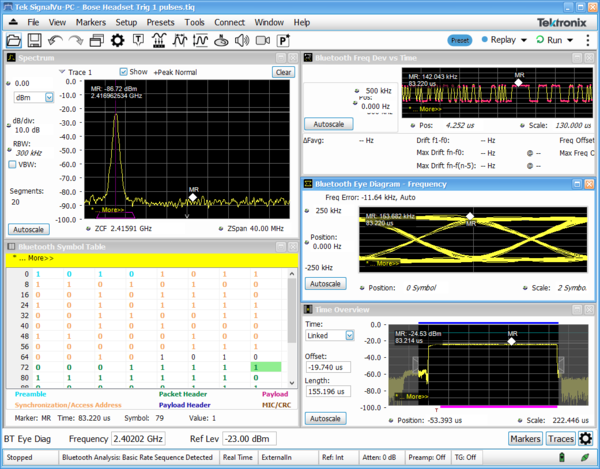
Mapping
When paired with the Alaris Smart Antenna with electronic compass, and battery-powered RSA500 Series (with built-in GPS transceiver) or RSA306B (with third party GPS dongle), the Mapping (MAP) application enables interference hunting, spectrum clearing, coverage mapping, surveying, and triangulation on signal sources.
Locate interference with an azimuth function that lets you draw a line or an arrow on a mapped measurement to indicate the direction your antenna was pointing when you took a measurement. You can also create and display measurement results and labels.
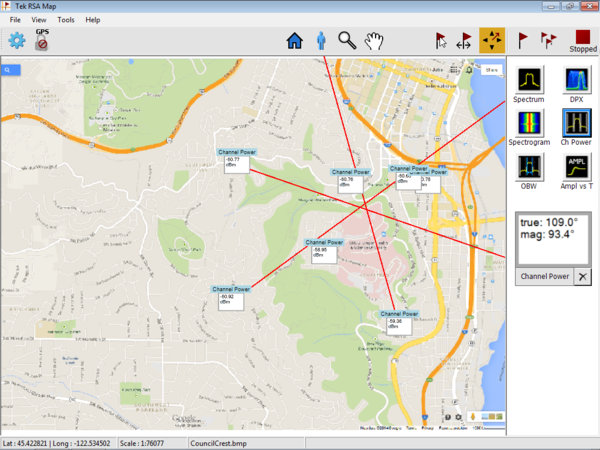
LTE FDD and TDD base station transmitter RF testing
Option SV28 enables the following LTE measurements:
Cell ID
Channel Power
Occupied Bandwidth (OBW)
Adjacent Channel Leakage Ratio (ACLR)
Spectrum Emission Mask (SEM)
Transmitter Off Power for TDD
Reference Signal Power
There are four presets to accelerate pre-compliance testing and determine the Cell ID. These presets are defined as Cell ID, ACLR, SEM, Channel Power and TDD Toff Power. The measurements follow the definition in 3GPP TS Version 12.5 and support all base station categories, including picocells and femtocells. Pass/Fail information is reported and all channel bandwidths are supported.
The Cell ID preset displays the Primary Synchronization Signal (PSS) and the Secondary Synchronization Signal (SSS) in a Constellation diagram. It also provides Frequency Error and Reference Signal (RS) Power.
The ACLR preset measures the E-UTRA and the UTRA adjacent channels, with different chip rates for UTRA. ACLR also supports Noise Correction based on the noise measured when there is no input. Both ACLR and SEM will operate in swept mode (default) or in faster single acquisition if the instrument has enough acquisition bandwidth.
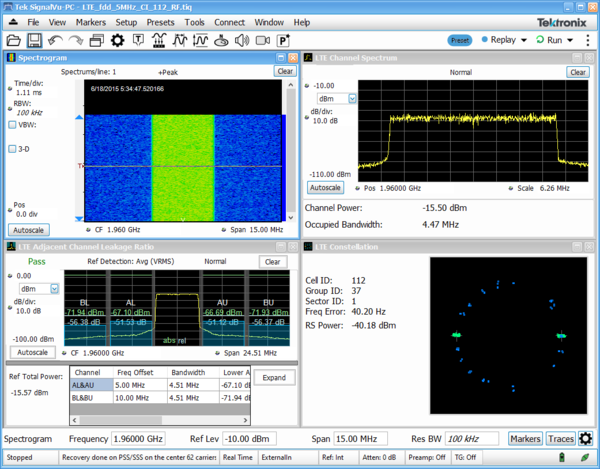
5G NR modulation analysis and measurements option
5G NR is among the growing set of signal standards, applications, and modulation types supported by SignalVu-PC Vector Signal Analysis (VSA) software. The SignalVu-PC VSA 5G NR analysis option provides comprehensive analysis capabilities in the frequency, time, and modulation domains for FR1 and FR2 (mmWave) signals based on the 3GPP’s 5G NR specification.
By configuring result traces of spectrum, acquisition time, and NR specific modulation quality (e.g, EVM, frequency error, I/Q error) traces and tables, engineers can identify overall signal characteristics and troubleshoot intermittent error peaks or repeated synchronization failures.
Error Vector Magnitude (EVM) is a figure of merit used to describe signal quality. It does this by measuring the difference on the I/Q plane between the ideal constellation point of the given symbol versus the actual measured point. It can be measured in dB or % of the ideal sub-symbol, normalized to the average QAM power received, and display constellation of symbols vs ideal symbol. The EVM vs Symbol or EVM vs Time gives the EVM of OFDM symbols present in the number of symbols considered or the time within a slot.
For automated testing, SCPI remote interfaces are available to accelerate design, which enables the quick transition to the design verification and manufacturing phases.
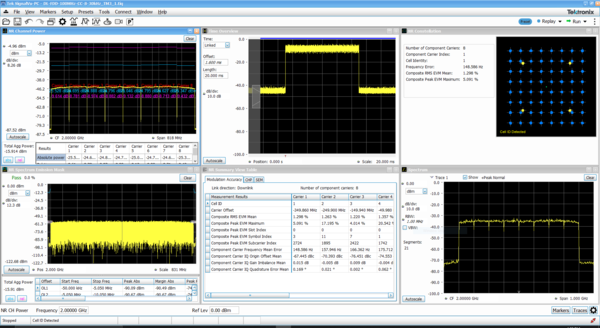
5G NR transmitter measurements core supported features
5G NR option (5GNRNL-SVPC)4 supports 5G NR modulation analysis measurements according to Release 15 and Release 16 of 3GPP’s TS38 specification, including:
- Analysis of uplink and downlink frame structures
- 5G NR measurements and displays including
- Modulation Accuracy (ModAcc)
- Channel Power (CHP)
- Adjacent Channel Power (ACP)
- Spectrum Emission Mask (SEM)
- Occupied Bandwidth (OBW)
- Power Vs Time (PVT)5
- Error Vector Magnitude (EVM)
- Summary table with all scalar results for ModAcc, SEM, CHP, ACP, OBW, PVT, and EVM measurements
- In-depth analysis and troubleshooting with coupled measurements across domains, use multiple markers to correlate results to find root-cause.
- Saves reports in CSV format with configuration parameters and measurement results
- Configurable parameters of PDSCH or PUSCH for each component carrier
- For downlink, supported test models for FDD and TDD per 3GPP specifications
WiGig IEEE802.11ad/ay 60 GHz Wi-Fi transmitter testing (offline analysis)
Options SV30NL-SVPC and SV30FL-SVPC provide offline analysis for WiGig IEEE802.11ad/ay IC characterization. However, Tektronix DPO70000SX Series oscilloscope with option SV30 installed can be used for full online 60 GHz measurements and analysis using SignalVu. For more details, refer to SignalVu-PC vs. SignalVu.
SV30 installed on an oscilloscope provides significant margin in EVM performance compared to what is required by the standard. Both Control PHY (802.11ad) and Single Carrier PHY (802.11ad and 802.11ay) are supported and provides analysis of 802.11ay 2.16 GHz packets or 4.23 GHz adjacent two-channel bonded packets.
Testing and verification can be done on IF and RF setups. RF power, Received Power Indicator (RCPI), Frequency error (Max, Average, Std. Deviation), DC Offset, IQ DC origin offset, IQ Gain and Phase imbalance, Signal Quality, and estimated SNR measurements are reported in the Summary display. Pass/Fail results are reported using customizable limits and the presets make the test set-up push-button.
For further insight into the signal, color coding is available in the user interface, allowing you to visualize the EVM spread across the analyzed packet with color codes differentiating regions. You can also view the demodulated symbols in tabular form with different color codes and with an option to traverse to the start of each region for easier navigation.
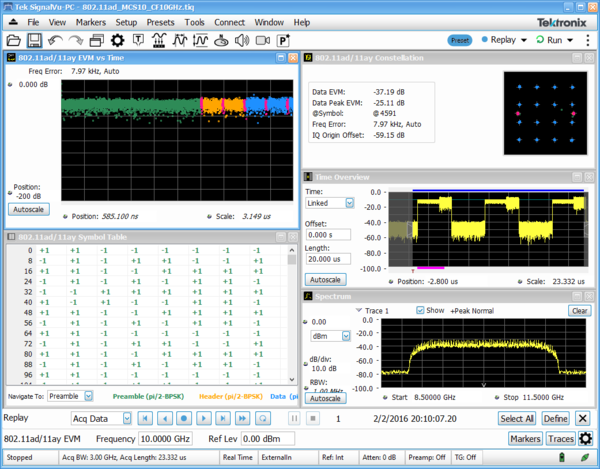
| Modulation formats | 802.11ad: MCS0-12.6 802.11ay: MCS1-21 |
802.11ad/ay Single carrier: π/2 BPSK, π/2 QPSK, π/2 16QAM, π/2 64QAM 802.11ad Control PHY: π/2 DBPSK | |
| Measurements | RF output power, Received Channel Power Indicator (RCPI), Estimated SNR, Frequency Error, Symbol Rate Error, IQ Origin Offset, IQ Phase Imbalance, IQ Gain Imbalance, IQ Quadrature Error, EVM results for each packet region (STF, CEF, Header and Data). Packet information includes the Packet type, Preamble, Synchronization Word or Access Code, Packet Header, Payload length, and CRC details. |
| Displays | Constellation, EVM vs Time, Symbol Table, Summary |
Playback of recorded files
With SV56, playback of recorded files from one of the USB spectrum analyzers is possible. Playback of recorded signals can reduce hours of watching and waiting for a spectral violation to minutes at your desk reviewing recorded data. Recording length is limited only by storage media size and recording is a basic feature included in SignalVu-PC. SignalVu-PC SV56 Playback allows for complete analysis by all SignalVu-PC measurements, including DPX Spectrogram. Minimum signal duration specifications are maintained during playback. AM/FM audio demodulation can be performed. Variable span, resolution bandwidth, analysis length, and bandwidth are all available. Frequency mask testing can be performed on recorded signals up to 40 MHz in span, with actions on mask violation including beep, stop, save trace, save picture, and save data. Portions of the playback can be selected and looped for repeat examination of signals of interest. Playback can be gap-free, or time gaps can be inserted to reduce review time. A Live Rate playback ensures fidelity of AM/FM demodulation and provides a 1:1 playback vs. actual time. Clock time of the recording is displayed in the spectrogram markers for correlation to real world events. In the illustration below, the FM band is being replayed, with a mask applied to detect spectral violations, simultaneous with listening to the FM signal at the center frequency of 92.3 MHz.
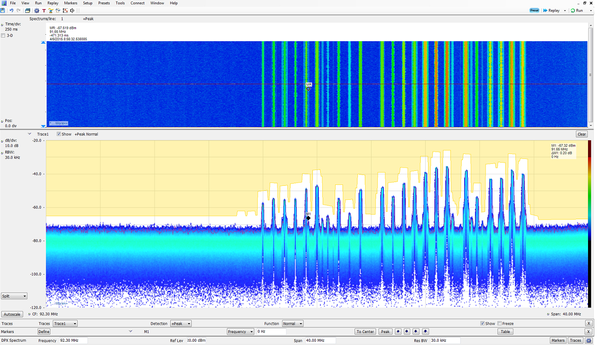
Signal survey
The signal classification application (SV54) enables expert systems guidance to aid the user in classifying signals. It provides graphical tools that allow you to quickly create a spectral region of interest, enabling you to classify and sort signals efficiently. The spectral profile mask, when overlaid on top of a trace, provides signal shape guidance, while frequency, bandwidth, channel number, and location are displayed allowing for quick checks. WLAN, GSM, W-CDMA, CDMA, Bluetooth standard and enhanced data rate, LTE FDD and TDD, and ATSC signals can be quickly and simply classified. Databases can be imported from your H500/RSA2500 signal database library for easy transition to the new software base.
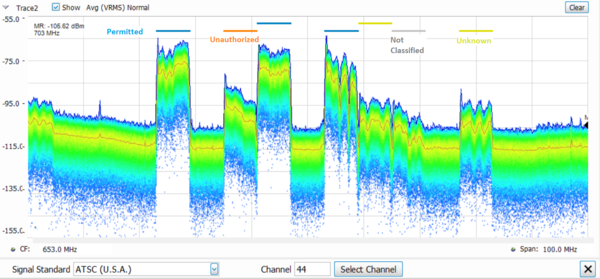
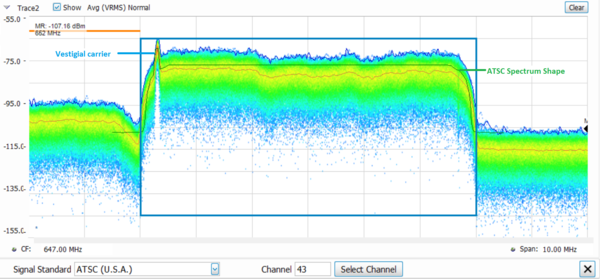
SignalVu-PC with mapping can be used to manually indicate the azimuth of a measurement made in the field, greatly aiding in triangulation efforts. The addition of a smart antenna able to report its direction to SignalVu-PC automates this process. Automatically plotting the azimuth/bearing of a measurement during interference hunting can greatly speed the time spent searching for the source of interference. Tektronix mapping capability provides support for the third-party Alaris DF-A0047 handheld direction finding antenna with frequency coverage from 20 MHz -8.5 GHz (optional 9 kHz-20 MHz) as part of a complete interference hunting solution. All SignalVu-PC data streams include time-stamp information for effective data logging and coherent signal analysis applications. Full specifications for the DF-A0047 antenna are available at https://www.alarisantennas.com/products/df-a0047-handheld-wideband-direction-finding-antenna/.
Automated phase noise and jitter measurements
Phase noise degrades the ability to process Doppler information in radar systems and degrades error vector magnitude in digitally modulation communication systems. Automated phase noise and jitter measurements with a spectrum analyzer (PHAS) may reduce the cost of your measurements by reducing the need for a dedicated phase noise analyzer.
Shown below, the phase noise of a 1 GHz carrier is measured at -133 dBc/Hz at 10 kHz offset. Single-sideband phase noise is displayed in dBc/Hz versus offset frequencies from carrier, shown in trace or tabular form: one ±Peak trace (in blue) and one average trace (in yellow). Trace smoothing and averaging is supported.
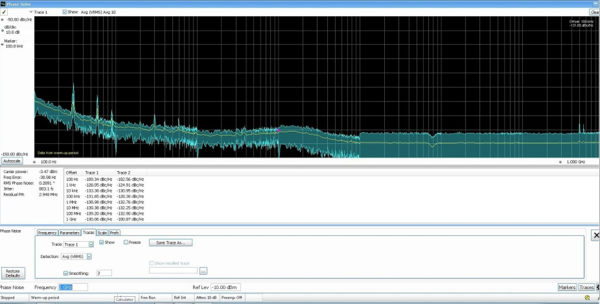
The RSA7100B's intrinsic phase noise of -134 dBc/Hz, at this frequency and across its operating range, provides ample measurement margin for a vast majority of applications.
Applications include testing VCO phase noise, oscillator phase noise, clock source jitter, signal generator phase noise, and more. The Tektronix phase noise / jitter application, when combined with DPX® signal processing, provides a powerful solution for designing and troubleshooting momentarily unstable signal sources.
The phase noise application performs automated carrier tracking, averaging, and dynamic measurement bandwidth adjustment, providing the accuracy and speed of measurement needed at all carrier offsets - ranging from 10 Hz to 1 GHz. Results are available in log-frequency trace or tabular form with pass/fail limits on-screen or via programmatic control. Integration limits are programmable for RMS phase noise, jitter, and residual FM. The low instrument phase noise of the RSA7100B together with this measurement application allows for high-performance phase noise measurements at frequencies up to 26.5 GHz.
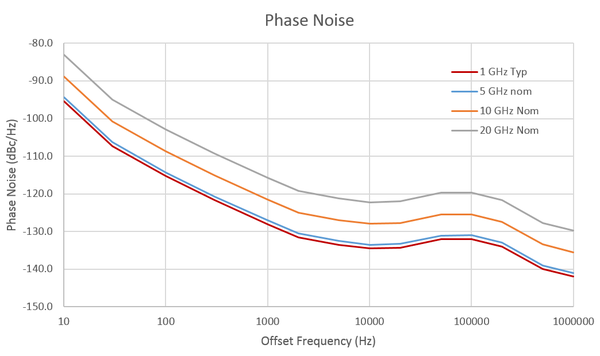
The previous figure shows the RSA7100B typical and nominal phase noise performance.
Education license
Qualified educational facilities can cost-effectively use SignalVu-PC in teaching environments. The specially priced education version includes all available applications except the 5GNR analysis option and provides results watermarked ‘Education Version’.
Measurement functions
| Spectrum analyzer measurements (base software) | Channel power, Adjacent channel power, Multicarrier adjacent channel Power/Leakage ratio, Occupied bandwidth, xdB down, Marker measurements of power, delta power, integrated power, power density, dBm/Hz, and dBc/Hz, Signal strength with audible feedback. |
| Time domain and statistical measurements (base software) | RF IQ vs time, Amplitude vs time, Power vs time, Frequency vs time, Phase vs time, CCDF, Peak-to-Average ratio, Amplitude, Frequency, and Phase modulation analysis. |
| Automated phase noise / jitter measurements (PHAS) (RSA7100 only) | Carrier power, Frequency error, RMS phase noise, Jitter, Residual FM. |
| WLAN 802.11a/b/g/j/p measurement application (SV23) | All of the RF transmitter measurements as defined in the IEEE standard, and a wide range of additional scalar measurements such as Carrier Frequency error, Symbol Timing error, Average/peak burst power, IQ Origin Offset, RMS/Peak EVM, and analysis displays, such as EVM and Phase/Magnitude Error vs time/frequency or vs symbols/ subcarriers, as well as packet header decoded information and symbol table. SV24 requires SV23. SV25 requires SV24. |
| WLAN 802.11n measurement application (SV24) | |
| WLAN 802.11ac measurement application (SV25) | |
| APCO P25 compliance testing and analysis application (SV26) | Complete set of push-button TIA-102 standard-based transmitter measurements with pass/fail results including ACPR, transmitter power and encoder attack times, transmitter throughput delay, frequency deviation, modulation fidelity, symbol rate accuracy, and transient frequency behavior, as well as HCPM transmitter logical channel peak ACPR, off slot power, power envelope, and time alignment. |
| Bluetooth Basic LE TX SIG measurements (SV27) | Presets for transmitter measurements defined by Bluetooth SIG for Basic Rate and Bluetooth Low Energy. Results also include Pass/Fail information. Application also provides Packet Header Field Decoding and can automatically detect the standard including Enhanced Data Rate. |
| Bluetooth 5 measurements (SV31) | Bluetooth SIG measurements for Bluetooth Low Energy version 5. Results also include Pass/Fail information. Application also provides Packet Header Field Decoding of LE Data Packets. SV31 requires SV27. |
| AM/FM/PM modulation and audio measurements (SVA) | Carrier power, frequency error, modulation frequency, modulation parameters (±peak, peak-peak/2, RMS), SINAD, modulation distortion, S/N, THD, TNHD, hum and noise. |
| Settling time (frequency and phase) (SVT) | Measured frequency, settling time from last settled frequency, settling time from last settled phase, settling time from trigger. Automatic or manual reference frequency selection. User-adjustable measurement bandwidth, averaging, and smoothing. Pass/Fail mask testing with 3 user-settable zones. |
| Advanced Pulse analysis (SVP) | Pulse-Ogram™ waterfall display of multiple segmented captures, with amplitude vs time and spectrum of each pulse. Pulse frequency, Delta Frequency, Average on power, Peak power, Average transmitted power, Pulse width, Rise time, Fall time, Repetition interval (seconds), Repetition interval (Hz), Duty factor (%), Duty factor (ratio), Ripple (dB), Ripple (%), Droop (dB), Droop (%), Overshoot (dB), Overshoot (%), Pulse- Ref Pulse frequency difference, Pulse- Ref Pulse phase difference, Pulse- Pulse frequency difference, Pulse- Pulse phase difference, RMS frequency error, Max frequency error, RMS phase error, Max phase error, Frequency deviation, Phase deviation, Impulse response (dB), Impulse response (time), Time stamp. Oscilloscopes support multi-channel analysis when used. |
| Flexible OFDM analysis (SVO) | OFDM analysis with support for WLAN 802.11a/g/j and WiMAX 802.16-2004. Constellation, Scalar measurement summary, EVM or power vs carrier, Symbol table (Binary or Hexadecimal). |
| General-purpose digital modulation analysis (SVM) | Error vector magnitude (EVM) (RMS, Peak, EVM vs Time), Modulation error ratio (MER), Magnitude Error (RMS, peak, mag error vs time),Phase error (RMS, Peak, Phase error vs time), Origin offset, Frequency error, Gain imbalance, Quadrature error, Rho, Constellation, Symbol table. FSK only: Frequency deviation, Symbol timing error. Oscilloscopes support multi-channel analysis when used. |
| Playback of recorded files (SV56) | Playback of files recorded with one of the USB spectrum analyzers (RSA306, RSA500, or RSA600). Controls for file selection, begin/end points. Rate controls for gap-free or live-rate playback. |
| LTE Downlink RF measurements (SV28) | Presets for Cell ID, ACLR, SEM, Channel Power and TDD Toff Power. Supports TDD and FDD frame format and all base stations defined by 3GPP TS version 12.5. Results include Pass/Fail information. Real-Time settings make the ACLR and the SEM measurements fast, if the connected instrument has required bandwidth. |
| 5G NR Measurements (5GNRNL-SVPC) | Presets for Channel Power (CHP), Adjacent Channel Power (ACP), Power Vs Time (PVT)5, Modulation Accuracy (including Error Vector Magnitude (EVM), Frequency Error, IQ Error), EVM vs. Symbol, Occupied Bandwidth (OBW), Spectral Emission Mask (SEM), Constellation Diagram, and summary table with scalar results. |
| WiGig IEEE 802.11ad/ay (SV30) (For offline analysis only. Real-time 60 GHz measurements can be made with Opt. SV30 on DPO70000SX Series oscilloscopes.) | Presets for Control PHY (802.11ad) and Single Carrier PHY (802.11ad and 802.11ay). The 802.11ay analysis results are shown for the EDMG, PreEDMG1, and PreEDMG2 regions. The 802.11ad preset measures EVM in each of the packet fields per the standard, and decodes the header packet information. RF power, Received Channel Power Indicator, Frequency error, IQ DC origin offset, IQ Gain and Phase imbalance are reported in the Summary display. Pass/Fail results are reported using customizable limits. |
| CISPR Detectors (Quasi Peak and Average) (SVQP) | This option enables CISPR Quasi Peak and Average detectors (defined per CISPR16) in Spectrum and Spurious displays. |
| EMC/EMI pre-compliance and troubleshooting (EMCVU) | This option supports many predefined limit lines. It also adds a wizard for easy setup of recommended antennas, LISN, and other EMC accessories with a one-button push. When using the new EMC-EMI display, you can accelerate the test by applying the time consuming quasi peak only on failures. This display also provides a push-button ambient measurement. The Inspect tool lets you measure frequencies of interest locally, removing the need for scanning. |
Specifications
Performance (typical)
- Frequency-related
- Frequency range
- See appropriate instrument data sheet
- Initial center frequency setting accuracy
- Equal to time-base accuracy of instrument
- Center frequency setting resolution
- 0.1 Hz
- Frequency offset range
- 0 Hz to the maximum bandwidth of the oscilloscope
- Frequency marker readout accuracy
- ±(Reference Frequency Error × Marker Frequency + 0.001 × Span + 2) Hz
- Span accuracy
- ±0.3%
- Reference frequency error
- Equal to oscilloscope reference frequency accuracy, aging, and drift. Refer to appropriate DPO/MSO data sheet.
- Tuning Tables
- Tables that present frequency selection in the form of standards-based channels are available for the following.
- Cellular standards families: AMPS, NADC, NMT-450, PDC, GSM, CDMA, CDMA-2000, 1xEV-DO WCDMA, TD-SCDMA, LTE, WiMax
- Unlicensed short range: 802.11a/b/j/g/p/n/ac, Bluetooth
- Cordless phone: DECT, PHS
- Broadcast: AM, FM, ATSC, DVBT/H, NTSC
- Mobile radio, pagers, other: GMRS/FRS, iDEN, FLEX, P25, PWT, SMR, WiMax
- Analysis-related
- Frequency (base software)
- Spectrum (amplitude vs linear or log frequency)
- Spectrogram (amplitude vs frequency over time)
- Time and statistics (base software)
- Amplitude vs time
- Frequency vs time
- Phase vs time
- Amplitude modulation vs time
- Frequency modulation vs time
- Phase modulation vs time
- RF IQ vs time
- Time overview
- CCDF
- Peak-to-Average ratio
- Settling time, frequency, and phase (SVT)
- Frequency settling vs time
- Phase settling vs time
- Advanced Pulse measurements suite (SVP)
- Pulse results table
- Pulse trace (selectable by pulse number)
- Pulse statistics (trend of pulse results, FFT of time trend, and histogram)
- Cumulative statistics
- Cumulative histogram
- Pulse-Ogram
- Digital demod (SVM)
- Constellation diagram
- EVM vs Time
- Symbol table (binary or hexadecimal)
- Magnitude and phase error vs time, and signal quality
- Demodulated IQ vs time
- Eye diagram
- Trellis diagram
- Frequency deviation vs time
- Flexible OFDM (SVO)
- EVM vs Symbol, vs Subcarrier
- Subcarrier power vs symbol, vs subcarrier
- Subcarrier constellation
- Symbol data table
- Mag error vs Symbol, vs Subcarrier
- Phase error vs Symbol, vs Subcarrier
- Channel frequency response
- Automated phase noise and jitter measurements (PHAS)
- Carrier power
- Frequency error
- RMS phase noise
- Jitter
- Residual FM
- WLAN measurements (SV23, SV24, SV25 or SV2C)
- Burst index
- Burst power
- Peak to average burst power
- IQ origin offset
- Frequency error
- Common pilot error
- Symbol clock error
- RMS and Peak EVM for Pilots/Data
- Peak EVM located per symbol and subcarrier
- Packet header format information
- Average power and RMS EVM per section of the header
- WLAN power vs Time or vs Symbol
- Burst Width
- WLAN symbol table
- WLAN Constellation
- Spectrum emission mask
- Spurious
- EVM vs symbol (or time), vs subcarrier (or frequency)
- Mag error vs symbol (or time), vs subcarrier (or frequency)
- Phase error vs symbol (or time), vs subcarrier (or frequency)
- WLAN channel frequency response vs symbol (or time), vs subcarrier (or frequency)
- WLAN spectral flatness vs symbol (or time), vs subcarrier (or frequency)
- APCO P25 measurement application (SV26)
- RF output power, operating frequency accuracy, modulation emission spectrum, unwanted emissions spurious, adjacent channel power ratio, frequency deviation, modulation fidelity, frequency error, eye diagram, symbol table, symbol rate accuracy, transmitter power and encoder attack time, transmitter throughput delay, frequency deviation vs. time, power vs. time, transient frequency behavior, HCPM transmitter logical channel peak adjacent channel power ratio, HCPM transmitter logical channel off slot power, HCPM transmitter logical channel power envelope, HCPM transmitter logical channel time alignment, cross-correlated markers
- Bluetooth Basic LE Tx (SV27) and Bluetooth 5 (SV31) Measurements
- Peak Power, Average Power, Adjacent Channel Power or InBand Emission mask, -20dB Bandwidth, Frequency Error, Modulation Characteristics including ΔF1avg (11110000), ΔF2avg (10101010), ΔF2 > 115 kHz, ΔF2/ΔF1 ratio, frequency deviation vs. time with packet and octet level measurement information, Carrier Frequency f0, Frequency Offset (Preamble and Payload), Max Frequency Offset, Frequency Drift f1-f0, Max Drift Rate fn-f0 and fn-fn-5, Center Frequency Offset Table and Frequency Drift table, color-coded Symbol table, Packet header decoding information, eye diagram, constellation diagram, editable limits
- LTE Downlink RF measurements (SV28)
- Adjacent Channel Leakage Ratio (ACLR), Spectrum Emission Mask (SEM), Channel Power, Occupied Bandwidth, Power vs. Time displaying Transmitter OFF power for TDD signals and LTE constellation diagram for PSS, SSS with Cell ID, Group ID, Sector ID, Reference Signal (RS) Power, and Frequency Error.
- 5G NR Uplink/Downlink measurements (5GNRNL-SVPC)
- Channel Power (CHP), Adjacent Channel Power (ACP), Power Vs Time (PVT)5, Modulation Accuracy (including Error Vector Magnitude (EVM), Frequency Error, IQ Error), EVM vs. Symbol, Occupied Bandwidth (OBW), Spectral Emission Mask (SEM), Constellation Diagram, and summary table with scalar results.
- WiGig 802.11ad/ay Measurements (SV30) (Offline analysis)
- RF output power, Received Channel Power Indicator (RCPI), Estimated SNR, Frequency Error, Symbol Rate Error, IQ Origin Offset, IQ Gain Imbalance, IQ Phase Imbalance, IQ Quadrature Error,
- EVM results for each packet region: Packet information, 802.11ad (STF, CEF, Header, Guard, and Data), 802.11ay (LSTF, LCEF, L Header, EDMG Header-A, EDMG STF, EDMG CEF Guard and Data) including the Packet type, Preamble, Synchronization Word or Access Code, Packet Header, Payload length, and CRC details.
Signal strength
- Signal Strength display
- Signal strength indicator
- Located at right side of display
- Measurement bandwidth
- Up to 40 MHz, dependent on span and RBW setting
- Tone type
Variable frequency based on received signal strength
AM/FM/PM modulation and audio measurements (SVA)
All published performance based on conditions of Input Signal: 0 dBm, Input Frequency: 100 MHz, RBW: Auto, Averaging: Off, Filters: Off. Sampling and input parameters optimized for best results.
- Carrier frequency range6
- 1 kHz or (1/2 × audio analysis bandwidth) to maximum input frequency
- Maximum audio frequency span
- 10 MHz
- Audio filters
- Low pass (kHz)
- 0.3, 3, 15, 30, 80, 300, and user-entered up to 0.9 × audio bandwidth
- High pass (Hz)
- 20, 50, 300, 400, and user-entered up to 0.9 × audio bandwidth
- Standard
- CCITT, C-Message
- De-emphasis (µs)
- 25, 50, 75, 750, and user-entered
- File
- User-supplied .TXT or .CSV file of amplitude/frequency pairs. Maximum 1000 pairs.
- FM modulation analysis
- FM measurements,
- Carrier power, carrier frequency error, audio frequency, deviation (+peak, –peak, peak-peak/2, RMS), SINAD, modulation distortion, S/N, total harmonic distortion, total non-harmonic distortion, hum and noise
- FM deviation accuracy
- ±1.5% of deviation
- FM rate accuracy
- ±1.0 Hz
- Carrier frequency accuracy
- ±1 Hz + (transmitter frequency × reference frequency error)
- Residuals (FM) (rate: 1 kHz to 10 kHz, deviation: 5 kHz)
- THD
- 0.2% (MSO/DPO70000)
- SINAD
- 44 dB (MSO/DPO70000)
- AM modulation analysis
- AM measurements
- Carrier power, audio frequency, modulation depth (+peak, –peak, peak-peak/2), RMS, SINAD, modulation distortion, S/N, total harmonic distortion, total non-harmonic distortion, hum and noise
- AM depth accuracy (rate: 1 kHz, depth: 50%)
- ±1% + 0.01 × measured value
- AM rate accuracy (rate: 1 kHz, depth: 50%)
- ±1.0 Hz
- Residuals (AM)
- THD
- 0.3% (MSO/DPO70000)
- SINAD
- 48 dB (MSO/DPO70000)
- PM modulation analysis
- PM measurement
- Carrier power, carrier frequency error, audio frequency, deviation (+peak, –peak, peak-peak/2, RMS), SINAD, modulation distortion, S/N, total harmonic distortion, total non-harmonic distortion, hum and noise
- PM deviation accuracy (rate: 1 kHz, deviation: 0.628 rad)
- ±100% × (0.01 + (rate / 1 MHz))
- PM rate accuracy (rate: 1 kHz, deviation: 0.628 rad)
- ±1 Hz
- Residuals (PM)
- THD
- 0.1% (MSO/DPO70000)
- SINAD
- 48 dB (MSO/DPO70000)
- Direct audio input
- Audio measurements
- Signal power, audio frequency (+peak, –peak, peak-peak/2, RMS), SINAD, modulation distortion, S/N, total harmonic distortion, total non-harmonic distortion, hum and noise
- Direct input frequency range (for audio measurements only)
1 Hz to 10 MHz
- Maximum audio frequency span
10 MHz
- Audio frequency accuracy
- ±1 Hz
- Residuals (PM)
- THD
- 1.5%
- SINAD
- 38 dB
- Minimum audio analysis bandwidth and RBW vs. oscilloscope memory and sample rate (SVA)
Model Sample rate: 1 GS/s Sample rate: maximum Standard memory Maximum memory Standard memory Maximum memory Min. Aud. BW RBW (Auto) Min. Aud. BW RBW (Auto) Min. Aud. BW RBW (Auto) Min. Aud. BW RBW (Auto) DPO/MSO 70000 ≥ 12.5 GHz BW 200 kHz 400 Hz 10 kHz 20 Hz Not recom-mended > 4 kHz 1 MHz 2 kHz DPO/MSO 70000 < 12.5 GHz BW 200 kHz 400 Hz 20 kHz 40 Hz Not recom-mended > mee4 kHz 500 kHz 1 kHz
Settling time, frequency, and phase (SVT)
- Settled frequency uncertainty7
- Measurement frequency: 1 GHz
Averages Frequency uncertainty at stated measurement bandwidth 1 GHz 100 MHz 10 MHz 1 MHz Single measurement 20 kHz 2 kHz 500 Hz 100 Hz 100 averages 10 kHz 500 Hz 200 Hz 50 Hz 1000 averages 2 kHz 200 Hz 50 Hz 10 Hz - Measurement frequency: 9 GHz
Averages Frequency uncertainty at stated measurement bandwidth 1 GHz 100 MHz 10 MHz 1 MHz Single Measurement 20 kHz 5 kHz 2 kHz 200 Hz 100 Averages 10 kHz 2 kHz 500 Hz 50 Hz 1000 Averages 2 kHz 500 Hz 200 Hz 20 Hz
- Settled phase uncertainty7
- Measurement frequency: 1 GHz
Averages Phase uncertainty at stated measurement bandwidth 1 GHz 100 MHz 10 MHz 1 MHz Single measurement 2° 2° 2° 2° 100 averages 0.5° 0.5° 0.5° 0.5° 1000 averages 0.2° 0.2° 0.2° 0.2° - Measurement frequency: 9 GHz
Averages Phase uncertainty at stated measurement bandwidth 1 GHz 100 MHz 10 MHz 1 MHz Single measurement 5° 5° 5° 5° 100 averages 2° 2° 2° 2° 1000 averages 0.5° 0.5° 0.5° 0.5°
Advanced Pulse measurement suite (SVP)
- General characteristics
- Measurements
- Pulse-Ogram™ waterfall display of multiple segmented captures, with amplitude vs time and spectrum of each pulse. Pulse frequency, Delta Frequency, Average on power, Peak power, Average transmitted power, Pulse width, Rise time, Fall time, Repetition interval (seconds), Repetition interval (Hz), Duty factor (%), Duty factor (ratio), Ripple (dB), Ripple (%), Droop (dB), Droop (%), Overshoot (dB), Overshoot (%), Pulse- Ref Pulse frequency difference, Pulse- Ref Pulse phase difference, Pulse- Pulse frequency difference, Pulse- Pulse phase difference, RMS frequency error, Max frequency error, RMS phase error, Max phase error, Frequency deviation, Phase deviation, Impulse response (dB), Impulse response (time), Time stamp.
- System rise time (typical)
- Equal to oscilloscope rise time
- Minimum pulse width for detection8
Model Minimum PW MSO54 300 ps MSO56 300 ps MSO58 300 ps MSO64B 300 ps MSO66B 300 ps MSO68B 300 ps
- Pulse measurement accuracy (typical)8
- Average on power
- ±0.3 dB + Absolute Amplitude Accuracy of instrument
- Average transmitted power
- ±0.4 dB + Absolute Amplitude Accuracy of instrument
- Peak power
- ±0.4 dB + Absolute Amplitude Accuracy of instrument
- Pulse width
- ±(3% of reading + 0.5 × sample period)
- Pulse repetition rate
- ±(3% of reading + 0.5 × sample period)
Digital modulation analysis (SVM)
- Modulation formats
- π/2DBPSK, BPSK, SBPSK, QPSK, DQPSK, π/4DQPSK, D8PSK, 8PSK, OQPSK, SOQPSK, CPM, 16/32/64/128/256/1024QAM, MSK, 2-FSK, 4-FSK, 8-FSK, 16-FSK, C4FM, D16PSK, 16APSK, and 32APSK
- Analysis period
- Up to 80,000 samples
- Measurement filters
- Square-root raised cosine, raised cosine, Gaussian, rectangular, IS-95, IS-95 EQ, C4FM-P25, half-sine, None, User Defined
- Reference filters
- Raised cosine, Gaussian, rectangular, IS-95, SBPSK-MIL, SOQPSK-MIL, SOQPSK-ARTM, None, User Defined
- Alpha/B x T range
- 0.001 to 1, 0.001 step
- Measurements
Constellation, Error Vector Magnitude (EVM) vs time, Modulation error ratio (MER), Magnitude error vs time, Phase error vs time, Signal quality, Symbol table
rhoFSK only: Frequency deviation, Symbol timing error
- Symbol rate range
- 1 kS/s to (0.4 * Sample Rate) GS/s (modulated signal must be contained entirely within the acquisition bandwidth)
- Adaptive equalizer
- Type
- Linear, decision-directed, feed-forward (FIR) equalizer with coefficient adaptation and adjustable convergence rate
- Modulation types supported
- π/2 DBPSK, BPSK, SBPSK, QPSK, DQPSK, π/4 DQPSK, D8PSK, 8PSK, D16PSK, OQPSK, SOQPSK, CPM, 16/32/64/128/256/1024QAM, MSK, 2-FSK, 4-FSK, 8-FSK, 16-FSK, C4FM
- Reference filters for all modulation types except OQPSK
- Raised Cosine, Rectangular, None
- Reference filters for OQPSK
- Raised Cosine, Half Sine
- Filter length
- 1-128 taps
- Taps/symbol: raised cosine, half sine, no filter
- 1, 2, 4, 8
- Taps/symbol: rectangular filter
- 1
- Equalizer controls
- Off, Train, Hold, Reset
- 16QAM Residual EVM (typical) for DPO/MSO70000 series8
Symbol Rate RF IQ 100 MS/s < 2.0% < 2.0% 312.5 MS/s < 3.0% < 3.0%
- OFDM residual EVM, 802.11g Signal at 2.4 GHz, input level optimized for best performance
- DPO/MSO70000 Series
- –38 dB
WLAN IEEE802.11a/b/g/j/p (SV23)
- General characteristics
- Modulation formats
- DBPSK (DSSS1M), DQPSK (DSSS2M), CCK5.5M, CCK11M , OFDM (BPSK, QPSK, 16 or 64QAM)
- Measurements and displays
- Burst Index, Burst Power, Peak to Average Burst Power, IQ Origin Offset, Frequency Error, Common Pilot Error, Symbol Clock Error
- RMS and Peak EVM for Pilots/Data, Peak EVM located per Symbol and Subcarrier
- Packet Header Format Information
- Average Power and RMS EVM per section of the header
- WLAN Power vs Time, WLAN Symbol Table, WLAN Constellation
- Spectrum Emission Mask11, Spurious
- Error Vector Magnitude (EVM) vs Symbol (or Time), vs Subcarrier (or Frequency)
- Mag Error vs Symbol (or Time), vs Subcarrier (or Frequency)
- Phase Error vs Symbol (or Time), vs Subcarrier (or Frequency)
- WLAN Channel Frequency Response vs Symbol (or Time), vs Subcarrier (or Frequency)
- WLAN Spectral Flatness vs Symbol (or Time), vs Subcarrier (or Frequency)
WLAN IEEE802.11n (SV24)
- General characteristics
- Modulation formats
- SISO, OFDM (BPSK, QPSK, 16 or 64QAM)
- Measurements and displays
- Burst Index, Burst Power, Peak to Average Burst Power, IQ Origin Offset, Frequency Error, Common Pilot Error, Symbol Clock Error
- RMS and Peak EVM for Pilots/Data, Peak EVM located per Symbol and Subcarrier
- Packet Header Format Information
- Average Power and RMS EVM per section of the header
- WLAN Power vs Time, WLAN Symbol Table, WLAN Constellation
- Spectrum Emission Mask11 , Spurious
- Error Vector Magnitude (EVM) vs Symbol (or Time), vs Subcarrier (or Frequency)
- Mag Error vs Symbol (or Time), vs Subcarrier (or Frequency)
- Phase Error vs Symbol (or Time), vs Subcarrier (or Frequency)
- WLAN Channel Frequency Response vs Symbol (or Time), vs Subcarrier (or Frequency)
- WLAN Spectral Flatness vs Symbol (or Time), vs Subcarrier (or Frequency)
WLAN IEEE802.11ac (SV25)
- General characteristics
- Modulation formats
- SISO, OFDM (BPSK, QPSK, 16/64/256/1024QAM)
- Measurements and displays
Burst Index, Burst Power, Peak to Average Burst Power, IQ Origin Offset, Frequency Error, Common Pilot Error, Symbol Clock Error,
RMS and Peak EVM for Pilots/Data, Peak EVM located per Symbol and Subcarrier
Packet Header Format Information
Average Power and RMS EVM per section of the header
WLAN Power vs Time, WLAN Symbol Table, WLAN Constellation
Spectrum Emission Mask11, Spurious
Error Vector Magnitude (EVM) vs Symbol (or Time), vs Subcarrier (or Frequency)
Mag Error vs Symbol (or Time), vs Subcarrier (or Frequency)
Phase Error vs Symbol (or Time), vs Subcarrier (or Frequency)
WLAN Channel Frequency Response vs Symbol (or Time), vs Subcarrier (or Frequency)
WLAN Spectral Flatness vs Symbol (or Time), vs Subcarrier (or Frequency). For reference WLAN IEEE802.11a/b/g/j/p (SV23)
APCO P25 (SV26)
- Modulation formats
- Phase 1 (C4FM), Phase 2 (HCPM, HDQPSK)
- Measurements and displays
- RF output power, operating frequency accuracy, modulation emission spectrum,
unwanted emissions spurious, adjacent channel power ratio, frequency deviation,
modulation fidelity, frequency error, eye diagram, symbol table, symbol rate accuracy,
transmitter power and encoder attack time, transmitter throughput delay, frequency
deviation vs. time, power vs. time, transient frequency behavior, HCPM transmitter logical
channel peak adjacent channel power ratio, HCPM transmitter logical channel off slot power,
HCPM transmitter logical channel power envelope, HCPM transmitter logical channel time alignment
- Residual modulation fidelity (with 5/6 Series MSO, USB RF, RSA7100)
- Phase 1 (C4FM)
- ≤ 1.0% typical
- Phase 2 (HCPM)
- ≤ 0.5% typical
- Phase 2 (HDQPSK)
- ≤ 0.5% typical
- Adjacent channel power ratio
- 25 kHz offset from the center and bandwidth of 6 kHz 12
- Phase 1 (C4FM): -76 dBc typical
- Phase 2 (HCPM): -74 dBc typical
- Phase 2 (HDQPSK): -74 dBc typical
- 62.5 kHz offset from the center and bandwidth of 6 kHz
- Phase 1 (C4FM): -77 dBc typical
- Phase 2 (HCPM): -78 dBc typical
- Phase 2 (HDQPSK): -76 dBc typical
LTE Downlink RF measurements (SV28)
- Standard Supported
- 3GPP TS 36.141 Version 12.5
- Frame Format supported
- FDD and TDD
- Measurements and Displays Supported
- Adjacent Channel Leakage Ratio (ACLR), Spectrum Emission Mask (SEM), Channel Power, Occupied Bandwidth, Power vs. Time showing Transmitter OFF power for TDD signals and LTE constellation diagram for PSS, SSS with Cell ID, Group ID, Sector ID, Frequency Error, and Reference Signal (RS) Power.
- ACLR with E-UTRA bands (Typical Mean, with Noise Correction)
- 1st Adjacent Channel
61 dB (RSA600/RSA500); 65 dB (RSA306/B)
- 2nd Adjacent Channel
63 dB (RSA600/RSA500); 66 dB (RSA306/B)
5G NR Uplink/Downlink measurements (5GNRNL-SVPC)
- Standard supported
- TS 38.141-1 for BS and 38.521-1 for UE
- Modulation accuracy
- Sec 6.5.2 for BS and Sec 6.4.2 for UE.
- ACP
- Sec 6.6.3 for BS and Sec 6.5.2.4 for UE
- Frame format supported
- Uplink (FDD and TDD)
- Downlink (FDD and TDD)
- Measurements and displays supported
- Channel Power (CHP), Adjacent Channel Power (ACP), Power Vs Time (PVT)5, Modulation Accuracy (including Error Vector Magnitude (EVM), Frequency Error, IQ Error), EVM vs. Symbol, Occupied Bandwidth (OBW), Spectral Emission Mask (SEM), Constellation Diagram, and summary table with scalar results.
Measurements Frequency (GHz) MSO68B DPO77002SX RSA5126B RSA518A RSA306B 100 MHz Bandwidth 1CC 256 QAM UL 30 kHz subcarrier spacing. 20 MHz Bandwidth 1CC 256 QAM UL 30 kHz subcarrier spacing. ACLR < 7 GHz -48 dBc -48 dBc ≤ 48 dBc ≤ -48 dB < -48 dB EVM (typical) 1 GHz 0.31% 0.50% 0.40% 0.78% 1.28% 2 GHz 0.40% 0.50% - 0.93% 0.97% 3 GHz 0.40% 0.70% - - 1.13% 3.5 GHz - 0.70% 0.41% 1.04% 1.16% 4 GHz 0.48% 0.70% - - 1.08% 5 GHz 0.59% 0.70% 0.46% 0.87% 1.25% 6 GHz 0.68% 0.90% - 1.01% - 7 GHz 0.80% 0.90% 0.53% 1.05% - For 6 Series B MSO

For RSA5100B Series Spectrum Analyzers: ≤44.4 dB rms EVM from 1 GHz to 7 GHz

For RSA518 Series Spectrum Analyzers: ≤ 39.2 dB rms EVM from 1 GHz to 7 GHz

- Channel power accuracy
- ±1 dB, ±0.4 dB typical
- EVM (typical)
- ACLR (typical)
Bluetooth (SV27 and SV31)
- Modulation formats
- Bluetooth® 4.2 Basic Rate, Bluetooth® 4.2 Low Energy, Bluetooth® 4.2 Enhanced Data Rate. Bluetooth® 5 when SV31 is enabled.
- Measurements and displays
Peak Power, Average Power, Adjacent Channel Power or InBand Emission mask, -20 dB Bandwidth, Frequency Error, Modulation Characteristics including ΔF1avg (11110000), ΔF2avg (10101010), ΔF2 > 115 kHz, ΔF2/ΔF1 ratio, frequency deviation vs. time with packet and octet level measurement information, Carrier Frequency f0, Frequency Offset (Preamble and Payload), Max Frequency Offset, Frequency Drift f1-f0, Max Drift Rate fn-f0 and fn-fn-5, Center Frequency Offset Table and Frequency Drift table, color-coded Symbol table, Packet header decoding information, eye diagram, constellation diagram.
- Output power (Average and Peak Power)
- Level uncertainty
- Refer to instrument amplitude and flatness specification
- Measurement range
- Signal level > -70 dBm (for USB Spectrum Analyzers)
- Modulation Characteristics (ΔF1avg, ΔF2avg, ΔF2avg/ΔF1avg, ΔF2max ≥115 kHz)
- Deviation range
- ± 280 kHz
- Deviation uncertainty (at 0 dBm)
- < 2 kHz + instrument frequency uncertainty (Basic Rate)
- < 3 kHz + instrument frequency uncertainty (for USB spectrum analyzers and Low Energy)
- Measurement resolution
- 10 Hz
- Measurement range
- Nominal channel frequency ±100 kHz
- Initial Carrier Frequency Tolerance (ICFT)
- Measurement uncertainty (at 0 dBm)
- < 1 kHz + instrument frequency uncertainty (for USB Spectrum Analyzers)
- Measurement resolution
- 10 Hz
- Measurement range
- Nominal channel frequency ±100 kHz
- Carrier Frequency Drift (Max freq. offset, drift f1- f0, max drift fn-f0, max drift fn-fn-5 (50 μs))
- Measurement uncertainty
- < 2 kHz + instrument frequency uncertainty (for RSA306)
- < 1 kHz + instrument frequency uncertainty (for RSA600 and RSA500)
- Measurement resolution
- 10 Hz
- Measurement range
- Nominal channel frequency ±100 kHz
- In-band Emissions and ACP
- Level uncertainty
Refer to instrument amplitude and flatness specification
Phase noise and jitter measurements (PHAS)
- Supported instruments
- RSA7100A/B and 6 Series B MSO models
- Carrier frequency range
- 1 MHz to maximum instrument frequency
- Measurements
- Carrier power, Frequency error, RMS phase noise, Jitter (time interval error), Residual FM
- Residual Phase Noise
- See instrument phase noise specifications.
- Phase noise and jitter integration bandwidth range
Minimum offset from carrier: 10 Hz
Maximum offset from carrier: 1 GHz
- Number of traces
- 2
- Trace and measurement functions
Detection: average or ±Peak
Smoothing Averaging Optimization: speed or dynamic range
Mapping (MAP)
- Map types directly supported
- Pitney Bowes MapInfo (*.mif), Bitmap (*.bmp), Open Street Maps (.osm)
- Saved measurement results
Measurement data files (exported results)
Map file used for the measurements
Google earth KMZ file
Recallable results files (trace and setup files)
MapInfo-compatible MIF/MID files
WiGig 802.11ad/ay (SV30) measurements (Offline analysis only)
- WiGig 802.11ad/ay (SV30) Measurements
- (For offline analysis only. For online anlaysis, 60 GHz measurements can be made with Opt. SV30 on DPO70000SX Series oscilloscopes.)
- RF output power, Received Channel Power Indicator (RCPI), Estimated SNR, Frequency Error, Symbol Rate Error, IQ Origin Offset, IQ Gain Imbalance, IQ Phase Imbalance, IQ Quadrature Error,
- EVM results for each packet region: Packet information, 802.11ad (STF, CEF, Header, Guard, and Data), 802.11ay (LSTF, LCEF, L Header, EDMG Header-A, EDMG STF, EDMG CEF Guard and Data include the Packet type, Preamble, Synchronization Word or Access Code, Packet Header, Payload length, and CRC details.
Playback of recorded signals (SV56)
- Playback file type
R3F recorded by RSA306, RSA500, or RSA600
- Recorded file bandwidth
- 40 MHz
- File playback controls
- General: Play, stop, exit playback
Location: Begin/end points of playback settable from 0-100%
Skip: Defined skip size from 73 μs up to 99% of file size
Live rate: Plays back at 1:1 rate to recording time
Loop control: Play once, or loop continuously
- Memory requirement
- Recording of signals requires storage with write rates of 300 MB/sec. Playback of recorded files at live rates requires storage with read rates of 300 MB/sec.
EMC pre-compliance and troubleshooting (EMCVU)
- Standards
- EN55011, EN55012, EN55013, EN55014, EN55015, EN55025, EN55032, EN60601, DEF STAN, FCC Part 15, FCC Part18, MIL-STD 461G
- Features
- EMC-EMI display, Wizard to setup accessories and limit lines, Inspect, Harmonic Markers, Level Target, Compare Traces, Measure Ambient, Report generation, Re-measure Spot
- Detectors
+Peak, Avg, Avg (of logs), Avg (VRMS), CISPR QuasiPeak, CISPR Peak, CISPR Average, CISPR Average of Logs, MIL +Peak, DEF STAN Avg, DEF STAN Peak
- Limit lines
- Up to 3 Limit Lines with corresponding margins
- Resolution BW
- Set per standard or user definable
- Dwell time
- Set per standard or user definable
- Report format
- PDF, HTML, MHT,RTF, XLSX, Image File format
- Accessory type
- Antenna, Near Field Probe, Cable, Amplifier, Limiter, Attenuator, Filter, Other
- Correction format
- Gain/Loss Constant, Gain/loss table, Antenna Factor
- Traces
- Save/recall up to 5 traces, Math trace (trace1 minus trace2), Ambient trace
General characteristics
- CON
- Provides connection to Connect with 5 Series/ 6 Series/6 Series B MSO or 6 Series LPD Series Oscilloscopes (some features such as CISPR detectors are disabled)
- Update rate
- < 0.2 /sec (802.11ac EVM, acq BW: 200 MHz, record length: 400 µs)
- Programmatic interface
- SCPI-compliant command set. Requires installation of Tektronix Virtual Instrument Software Architecture (VISA) drivers
System requirements
Requirements
- Operating systems
- Windows 10 x64 or Windows 11 x64 13
- Windows 8 x64
- Disk space
- 20 GB free on C: drive
- RAM
- 1 GB (4 GB recommended)
Operation with one of the USB real-time spectrum analyzers has additional requirements. See the related instrument data sheet for details.
The 5G NR analysis is supported on Windows 10 (SignalVu-PC), 5 Series/6 Series/6 Series B MSO, and 6 Series LPD oscilloscope models.
Instruments and file types supported
- Instrument family
- Save different types of data for later recall and analysis including setups, screen captures, settings, results, traces, acquisition data, and gap-free recordings.
- Oscilloscopes
File type .WFM .TIQ .TIQM Performance: DPO70000SX
X X X Touchscreen Mixed-Domain: 5 Series/6 Series/6 Series B MSO
X X X - Real-time signal analyzers
File type .TIQ .IQT .CSV .R3F .CDIF .MAT RSA5000 X X X RSA306B X X X X X X RSA500/ 600 X X X X X X RSA7100 X X X X X - Other
File type .WFM .ISF .TIQ .IQT .MAT 3rd party waveforms in MATLAB Level 5 and Level 7.3 formats X
- SignalVu-PC vs. SignalVu
- SignalVu for oscilloscopes is a separate downloadable software application made to run directly on Tektronix performance oscilloscopes. With the base version (opt. SVE) SignalVu directly controls the acquisition settings of the MSO/DPO70000 SX/DX Series Oscilloscope and automatically transfers data from its acquisition system to the SignalVu software.
- SignalVu-PC is designed to run on a Windows 10, Windows 11 PC or tablet (64 bit) and the base version is free to download and use for controlling and analyzing acquisitions from Tektronix RSA306, RSA300/500/600 or RSA7100 Series Real-Time Spectrum (signal) Analyzers or for analyzing signals offline, without an instrument present.
- With 5/6 Series MSO or LPD64 oscilloscopes you may choose to install SignalVu-PC directly on the Windows 10 SSD of the oscilloscope (opt. 5/6-WIN required). With the base version (opt. RFVT and CONx license) SignalVu-PC directly controls the acquisition settings of the 5/6 Series MSO or LPD64 oscilloscopes and automatically transfers data from the oscilloscope acquisition system to the SignalVu-PC software. To support acquisition length of more than 10 ms for a span of 2 GHz or more, RL-1 (125 Mpoints record length) license needs to be installed.
Ordering information
Purchasing, licensing, and activation
SignalVu-PC and its applications are available for download at http://www.tektronix.com/downloads. EDUFL-SVPC is a bundle version of SignalVu-PC that includes all analysis applications except the 5GNR analysis option for educational institutions.
A variety of optional, licensed applications are available for purchase for SignalVu-PC. These licenses can be associated with and stored on either your PC or any RSA300 series, RSA500 series, RSA600 series, and RSA7100A spectrum analyzers. Licenses can be purchased as an option to your hardware or separately as a Node-locked or a Floating license.
Contact your local Tektronix Account Manager to purchase a license. If your purchased license is not ordered as an option to your instrument, you will receive an email with a list of the applications purchased and the URL to the Tektronix Product License Web page, where you will create an account and can then manage your licenses using the Tektronix Asset Management System (AMS): http://www.tek.com/products/product-license.
AMS provides an inventory of the license(s) in your account. It enables you to check out or check in a license and view the history of licenses.
Optional applications are enabled by one of the following license types.
| License type | Description |
|---|---|
| Node locked license (NL) purchased as an option to your instrument | When associated with an instrument, this license is factory-installed on that instrument at the time of manufacture. It will be recognized by any PC operating with SignalVu-PC when the instrument is connected. However, the licensed application is deactivated from the PC if the licensed instrument is disconnected. This is the most common form of licensing, as it simplifies management of your applications. |
| Node locked license (NL) purchased separately | This license is initially assigned to a specific host id, which can be either a PC or an instrument. It can be reassociated to either a PC or instrument two times using Tek AMS. This license is delivered via email and is associated with either your PC or with an instrument when you install the license. This license should be purchased when you want your license to stay on your PC, or if you have an existing USB instrument on which you would like to install a license. |
| Floating license(FL) purchased separately | This license can be moved between different host ids, which can be either PCs or instruments. It can be reassociated to different PCs or instruments an unlimited number of times using Tek AMS. This license is delivered via email and is associated with either your PC or with an instrument when you install the license. This is the most flexible license and is recommended in applications where the license needs to be moved frequently. |
In December 2015, the license policy and nomenclature was changed for SignalVu-PC and its options.
The legacy system is no longer supported and all customers are asked to transition to the new Tektronix license management system (TekAMS) going forward. Contact Tektronix sales or technical support for transferring previously purchased legacy license(s) to the new license file system.
The new license structure and the old options are shown below.
| Legacy SignalVu-PC option | New application license | License type | Description |
|---|---|---|---|
| SVA | SVANL-SVPC | NL | AM/FM/PM/Direct Audio analysis |
| SVAFL-SVPC | FL | ||
| SVT | SVTNL-SVPC | NL | Settling Time (frequency and phase) measurements |
| SVTFL-SVPC | FL | ||
| SVM | SVMNL-SVPC | NL | General-purpose digital modulation analysis |
| SVMFL-SVPC | FL | ||
| SVP | SVPNL-SVPC | NL | Advanced pulse radar analysis |
| SVPFL-SVPC | FL | ||
| SVO | SVONL-SVPC | NL | Flexible OFDM analysis |
| SVOFL-SVPC | FL | ||
Not available in legacy license | PHASNL-SVPC | NL | Automated phase noise/jitter measurements (RSA7100A and 6 Series B MSO only) |
| PHASFL-SVPC | FL | ||
| SV23 | SV23NL-SVPC | NL | WLAN 802.11a/b/g/j/p measurements |
| SV23FL-SVPC | FL | ||
| SV24 | SV24NL-SVPC | NL | WLAN 802.11n measurements (requires SV23) |
| SV24FL-SVPC | FL | ||
| SV25 | SV25NL-SVPC | NL | WLAN 802.11ac measurements (requires SV23 and SV24) |
| SV25FL-SVPC | FL | ||
| SV26 | SV26NL-SVPC | NL | APCO P25 measurements |
| SV26FL-SVPC | FL | ||
| SV27 | SV27NL-SVPC | NL | Bluetooth 4.2 measurements |
| SV27FL-SVPC | FL | ||
Not available in legacy license | SV31NL-SVPC | NL | Bluetooth 5 measurements (requires SV27) |
| SV31FL-SVPC | FL | ||
| MAP | MAPNL-SVPC | NL | Mapping |
| MAPFL-SVPC | FL | ||
| SV56 | SV56NL-SVPC | NL | Playback of recorded files |
| SV56FL-SVPC | FL | ||
| SV60 | SV60NL-SVPC | NL | Return loss, VSWR, cable loss, and distance to fault (requires option 04 on RSA500A/600A) |
| SV60FL-SVPC | FL | ||
| CON | CONNL-SVPC | NL | Live connection and base SignalVu-PC VSA measurements using the 5 or 6 Series MSO or LPD64 (requires Opt. SV-RFVT). |
| CONFL-SVPC | FL | ||
| SV2C | SV2CNL-SVPC | NL | Bundle of WLAN 802.11a/b/g/j/p/n/ac (SV23, SV24, and SV25) and live Connect (CON) to 5/6 Series MSO or LPD64 (requires Opt. SV-RFVT) |
| SV2CFL-SVPC | FL | ||
| SV28 | SV28NL-SVPC | NL | LTE Downlink RF measurements |
| SV28FL-SVPC | FL | ||
| Not available in legacy license | 5GNRNL-SVPC | NL14 | 5G NR Uplink/Downlink RF Power, Bandwidth, Demodulation, and Error Vector Magnitude Measurements15 |
| PHAS | PHASNL-SVPC | NL | Automated phase/jitter measurements (Available on the RSA7100A/B and 6 Series B MSO only) |
| PHASFL-SVPC | FL | ||
| Not available in legacy license | SV54NL-SVPC | NL | Signal survey and classification |
| SV54FL-SVPC | FL | ||
| Not available in legacy license | SVQPNL-SVPC | NL | EMI CISPR detectors |
| SVQPFL-SVPC | FL | ||
| Not available in legacy license | EMCVUNL-SVPC | NL | EMC pre-compliance and troubleshooting (includes EMI CISPR detectors) |
| EMCVUFL-SVPC | FL | ||
| SignalVu-PCEDU | EDUFL-SVPC | FL | Education-only version with all SignalVu-PC modules except 5GNR |
| Not available in legacy license | SV30NL-SVPC | NL | WiGig 802.11ad/ay measurements (only for offline analysis) 16 |
| SV30FL-SVPC | FL | ||
| Not available in legacy license | TRIGHNL-SVPC | NL | Advanced triggers (Frequency Mask, Density, Time Qualified) (RSA7100A/B only) |
| TRIGHNL-SVPC | FL | ||
| Not available in legacy license | STREAMNL-SVPC | NL | Streaming IQ data to RAID and 40 GbE (RSA7100A/B only) |
| STREAMNL-SVPC | FL |
Any of these licenses above enable SignalVu's advanced triggering capabilities: Time qualified, DPX density, and Frequency mask triggers.
SignalVu-PC application upgrades
Owners of SignalVu-PC applications can download any bug fixes or enhancements to existing products free of charge. New applications with new measurements may become available and upgrades can be purchased to add the new functionality using the ordering information described above.








